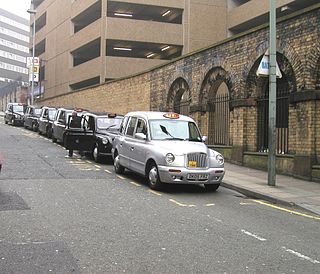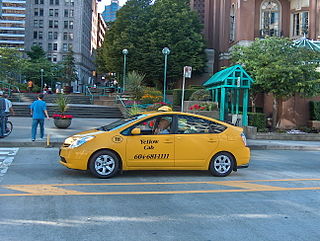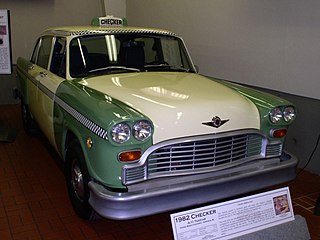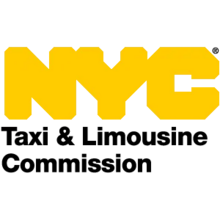
A chauffeur is a person employed to drive a passenger motor vehicle, especially a luxury vehicle such as a large sedan or a limousine.

A hackney or hackney carriage is a carriage or car for hire. A hackney of a more expensive or high class was called a remise. A symbol of London and Britain, the black taxi is a common sight on the streets of London. The hackney carriages carry a roof sign TAXI that can be illuminated to indicate their availability for passengers.

Checker Motors Corporation was a Kalamazoo, Michigan, vehicle manufacturer and tier-one subcontractor that manufactured taxicabs used by Checker Taxi. Morris Markin established the company in 1922, initially named the Checker Cab Manufacturing Company, in Chicago through a merger of Commonwealth Motors and Markin Automobile Body. The manufacturer moved to Kalamazoo in 1923 and was renamed to Checker Motors in 1958.

In New York City, taxicabs come in two varieties: yellow and green; they are widely recognizable symbols of the city. Taxis painted yellow are able to pick up passengers anywhere in the five boroughs. Those painted apple green, which began to appear in August 2013, are allowed to pick up passengers in Upper Manhattan, the Bronx, Brooklyn, Queens, and Staten Island. Both types have the same fare structure. Taxicabs are operated by private companies and licensed by the New York City Taxi and Limousine Commission (TLC). It also oversees over 40,000 other for-hire vehicles, including "black cars", commuter vans, and ambulettes.
Taxicabs within a country often share common properties, but there is a wide variation from country to country in the vehicles used, the circumstances under which they may be hired and the regulatory regime to which these are subject.
The taxicabs of the United States make up a mature system; most U.S. cities have a licensing scheme which restricts the number of taxicabs allowed. As of 2012 the total number of taxi cab drivers in the United States is 233,900; the average annual salary of a taxi cab driver is $22,820 and the expected percent job increase over the next 10 years is 16%.

Taxicabs are regulated throughout the United Kingdom, but the regulation of taxicabs in London is especially rigorous with regard to mechanical integrity and driver knowledge. An official report observed that: "Little however is known about the regulation by anyone outside the trade. The Public Carriage Office (PCO), which regulates and licenses taxis and private hire was transferred from the Metropolitan Police to become part of Transport for London in 2000." In 2015, there were around 298,000 licensed drivers in England, of which 164,000 were private hire licences, 62,000 were taxi licences and 72,000 were dual licences.

Taxis in Australia are highly regulated by each Australian state and territory, with each state and territory having its own history and structure. In December 2014, there were 21,344 taxis in Australia. Taxis in Australia are required to be licensed and are typically required to operate and charge on a fitted taximeter. Taxi fare rates are set by State or Territory governments. A vehicle without a meter is generally not considered to be a taxi, and may be described, for example, as a hire car, limousine, carpool, etc. Most taxis today are fueled by liquid petroleum gas. A2B Australia owns and operates the Cabcharge payment system, which covers 98% of taxis in Australia, and operates one of Australia's largest taxi networks.
Illegal taxicabs, sometimes known as pirate taxis, gypsy cabs, or jitney cabs, are taxicabs and other for-hire vehicles that are not duly licensed or permitted by the jurisdiction in which they operate. Most major cities worldwide require taxicabs to be licensed, safety-inspected, insured as for-hire vehicles, and to use taximeters, and there may also be requirements that the taxi driver be registered or accredited. However, many unlicensed cabs are in operation. Illegal cabs may be marked taxi vehicles, and others are personal vehicles used by an individual to offer unauthorized taxi-like services. Illegal cabs are prevalent in cities with medallion systems, which restrict the number of legal cabs in operation. Since their introduction in 2009, vehicles affiliated with ridesharing companies have been classified as illegal taxicabs in some jurisdictions.

A taxi, also known as a taxicab or simply a cab, is a type of vehicle for hire with a driver, used by a single passenger or small group of passengers, often for a non-shared ride. A taxicab conveys passengers between locations of their choice. This differs from public transport where the pick-up and drop-off locations are decided by the service provider, not by the customers, although demand responsive transport and share taxis provide a hybrid bus/taxi mode.

Rickshaws are used in numerous cities in the United States, primarily for their novelty value as an entertaining form of transportation for tourists and locals. However, they also have environmental benefits and may be quicker than other forms of transport if traffic congestion is high. Various laws regulate their use in different cities.
Taxicabs and other vehicles-for-hire in Canada are regulated by local municipalities and provinces, and are owned & operated by private companies and individuals. Unlicensed cabs in some cities are referred to as bandit taxis/cabs.

Hybrid taxi or hybrid electric taxi is a taxicab service provided with a hybrid electric car (HEV), which combines a conventional internal combustion engine propulsion system with an electric propulsion system.

Checker Taxi was a dominant taxicab company and national franchisor that was based in Chicago, Illinois. Checker Motors was an American vehicle manufacturer based in Kalamazoo, Michigan that built the iconic Checker Taxicab, sold commercially as the Checker Marathon until 1982. Both companies were owned by Morris Markin by the 1930s.

The Vehicle Production Group LLC was an American automobile manufacturer. Based in Miami, Florida, it made the wheelchair-accessible taxicabs, the MV-1, which was built in Mishawaka, Indiana at an AM General plant.

Boro taxis are taxicabs in New York City that are allowed to pick up passengers in outer boroughs and in Manhattan above East 96th and West 110th Streets. The color of boro taxis is apple green in contrast to the traditional yellow taxis in New York City.
Simon Garber is president and CEO of several taxi cab companies including Yellow Cab SLS Jet Management Corp in New York City and Chicago Carriage Cab Company in Chicago. Garber's companies are estimated to have the highest number of medallions in both Long Island City and Chicago, earning Garber the nickname of "Taxi King". Garber's cab companies have been involved in several scandals including the illegal use of salvaged police cars in the Chicago fleet and overcharging cab drivers in New York for leasing a medallion. In 2009, Garber founded the International Polo Club of Colts Neck near his residence in Colts Neck, New Jersey.
The New York City Office of Administrative Trials and Hearings (OATH) is an administrative office of the New York City government. It is a non-mayoral executive agency and is not part of the state Unified Court System.

A taxi medallion, also known as a CPNC, is a transferable permit in the United States allowing a taxicab to operate. Several major cities in the US use these in their taxi licensing systems, including New York City, Boston, Chicago, Philadelphia, and San Francisco.





















